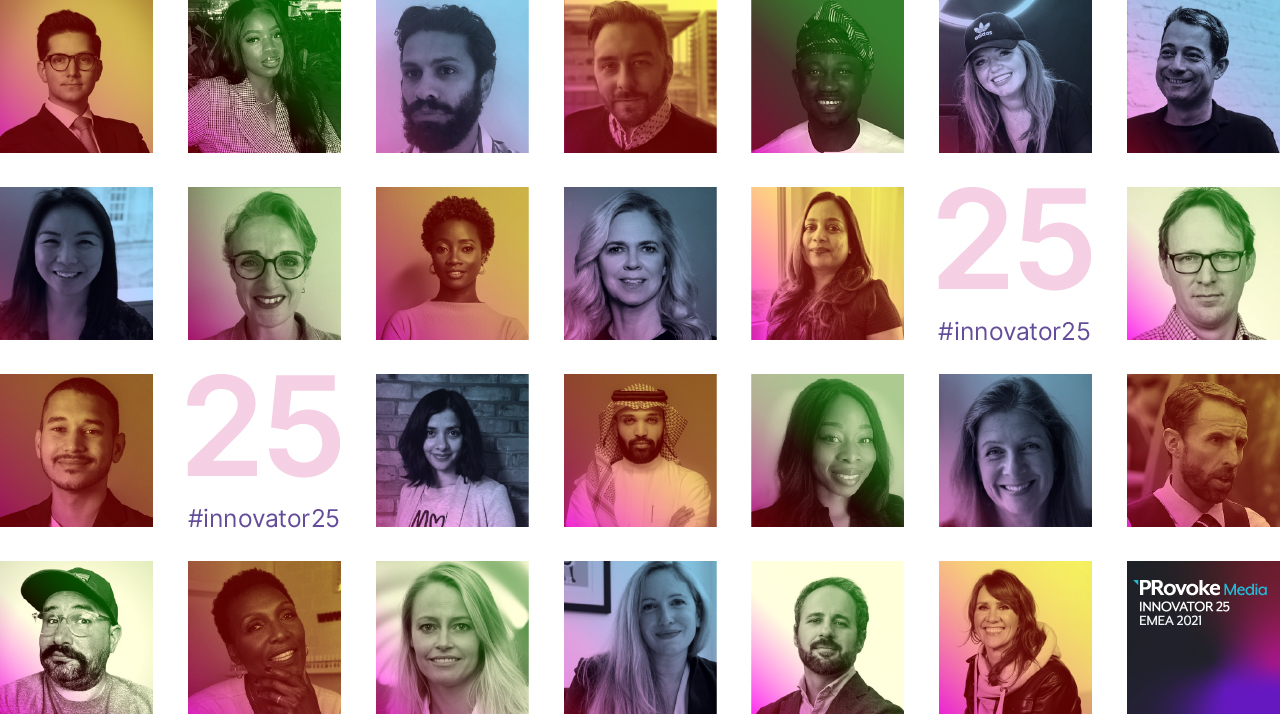
 Podcasts
PodcastsCatch the latest PR news & updates with PRovoke Media's PR Podcasts. Lifting the lid on key industry stories & trends, join our listeners of PR podcasts today.
 Videos
VideosLatest video interviews and campaigns from PRovoke Media, previously known as the Holmes Report.
Long-form journalism that analyzes the issues, challenges and opportunities facing the business and practice of PR.
 Profiles & Interviews
Profiles & InterviewsExplore PR profiles and interviews with leaders from the marketing and PR worlds.
 Crisis Review
Crisis ReviewPR Crisis & Business Crisis review. PRovoke Media's annual analysis of the top reputation crises to rock the corporate sector. Read on here.
 Coronavirus
CoronavirusPRovoke Media's coverage of the Covid-19 crisis, focusing on corporate communication, public affairs & PR industry fallout.
 Trend Forecasts
Trend ForecastsPRovoke Media's PR Trends round up. PRovoke Media's annual forecast of PR trends and news that will impact the PR world in the year ahead...
 Social & Digital
Social & DigitalDedicated to exploring the new frontiers of PR as it dives deeper into social media, content and analytics.
 Technology
TechnologyOur coverage of key technology PR trends and challenges from around the world of digital communications.
 Consumer
ConsumerFrom brand marketing to conscious consumerism, coverage of key marketing and PR trends worldwide.
 Employee Engagement
Employee EngagementPRovoke Media's coverage, analysis and news around the rapidly-shifting area of employee engagement and internal communications.
 Sports Marketing
Sports Marketing Sports PR news, diversity & inclusion trends, views and analysis from PRovoke Media. Subscribe today for the very latest in the world of sports communications.
 Global PR Agency Rankings
Global PR Agency RankingsPRovoke Media's definitive global benchmark of global PR agency size and growth.
Enter PRovoke Media's 2024 Global 250 Agency Ranking and/or our Agencies of the Year competitions now.
 Agencies of the Year
Agencies of the YearPRovoke Media's annual selections for PR Agencies of the Year, across all of the world's major markets.
 Innovator 25
Innovator 25PRovoke Media profiles marcomms innovators from across North America, EMEA and Asia-Pac.
 Creativity in PR
Creativity in PRIn-depth annual research into the PR industry's efforts to raise creative standards.
 Asia-Pacific Communication Index
Asia-Pacific Communication IndexAPACD/Ruder Finn annual study of Asia-Pacific in-house communications professionals.
 SABRE Awards
SABRE AwardsThe world's biggest PR awards programme, dedicated to benchmarking the best PR work from across the globe.
 PRovokeSummit Global
PRovokeSummit GlobalThe biggest PR conference of the year, a high-level forum designed to address the critical issues that matter most.
 PRovoke Media Regional Series
PRovoke Media Regional SeriesA global network of conferences that explore the innovation and disruption that is redefining public relations.
 Agencies of the Year
Agencies of the YearUnrivalled insight into the world's best PR agencies, across specialist and geographic categories.
 Roundtables
RoundtablesOur Roundtables bring together in-house comms leaders with PR firms to examine the future of communications.
 Agency Playbook
Agency PlaybookThe PR industry’s most comprehensive listing of firms from every region and specialty
.jpg) All Jobs
All JobsFind the latest global PR and communications jobs from PRovoke Media. From internships to account executives or directors. See all our PR jobs here.
PRovoke Media's editorial series published in collaboration with partners.

As head of group communications for the Abu Dhabi National Oil Company (ADNOC) for more than five years until he departed in October this year, Omar Zaafrani had a particularly complex brief, but managed to introduce a whole raft of innovations in the way the state-owned company approached communications, with huge impact. Zaafrani elevated the brand value of ADNOC and enhanced its reputation, turning it from just another oil company into a highly-admired global energy player. He built the company’s first communications, brand and CSR team to a 50-strong function, helped to unify the company and its 14 subsidiaries under a single brand and drove its culture transformation program. He also led communications around the public offering of ADNOC's fuel retail business, engaging with and securing buy-in from a diverse range of stakeholders. Under Zaafrani’s custodianship, the ADNOC brand was named the UAE’s most valuable for three consecutive years (2019-2021), secured a brand value of $10.8 billion for 2021, during an incredibly challenging year for the industry, making it the most resilient of all national oil Companies globally. During the pandemic, Omar also led employee engagement campaigns and deployed industry-leading organisational psychology and behavioural science models as part of ADNOC’s employee engagement outreach.
How would you describe the communications/PR industry's level of innovation compared to other marketing disciplines?
About the same.
Do you think the global pandemic has made the industry more innovative?
Yes.
Where is the PR industry's greatest opportunity for taking the lead on innovation?
Content creation.
Who most influences how innovative a brand's engagement is?
CCO.
How do you define innovation?
Innovation isn't simply about the adoption of technology, but rather the integration of cutting-edge practices and tools to more effectively reach and engage audiences, such as combining behavioural economic and nudge tactics with creative marketing to positively influence behaviour, or a fully virtual AGM coupled with the application of VR and AR in your annual report. At the same time, innovation can be the effective use of powerful storytelling in addressing, educating or raising awareness around delicate social issues. Issues such as diversity and inclusions, body image or cyber bullying – to name a few – that technology has propagated.
What is the most innovative comms/marketing initiative you've seen in the last 12 months?
There have been several great communications and marketing initiatives over the last twelve months, especially those related to the pandemic. However, I am a strong believer that the best initiatives, or the most innovative, are those that dare to address social issues. I have to take my hat off to Dove, once again, for their work to boost body positivity. Their initiative, “Reverse Selfie” where they address the impact of social media on self-esteem and how increased screen time, especially during the pandemic, is deepening the issue. In doing so, they’ve been successful in garnering trust from consumers while encouraging a dialogue on an growing issue being driven by today’s technology.
In your opinion, what brands and/or agencies are most innovative around PR and marketing?
There are so many great brands out there doing phenomenal work – it’s difficult to pick just one. Whether it is Dove’s body positivity campaigns, the tongue-in-cheek rivalry between McDonalds and Burger King, or Apple’s use of user-generated content for its #ShotOniPhone campaign, I believe brands are becoming better at being more innovative by keeping it simple.
Describe a moment in your career that you would consider 'innovative.'
The pandemic the past two years really forced us to think out-of-the-box and to innovate. Whether it was building virtual ecosystems for townhalls and a virtual visitor centre to engage our community, or stitching together videos with user-generated social content during the lockdown, we had to innovate to effectively communicate during the ‘new normal’. Most importantly, however, is how we used behavioural economics in our internal communications to help employees feel safe and secure to encourage the gradual return to the office.
Who do you admire for his/her approach to innovation?
I have to say, from a marketing point of view, that Ryan Reynolds – yes, the actor – and his agency Maximum Effort have really mastered the art of authentic marketing and micro-marketing – or as he likes to call it, “fast-vertising”. Whether it was the immediate turnaround of ‘Peloton Wife’ for Aviation Gin or the pandemic associated Match ad, they did a great job at leveraging immediate cultural moments to make the message relevant and engaging.
How do you get out of a creativity rut?
Watch stand-up comedy. If that doesn’t work, I go for a run. And if all else fails, I meditate, disconnect and calm my mind. After I settle, I like to sketch out ideas, let them rest and evaluate them the next morning.
What advice would you give to the PR industry around embracing innovation?
Don’t overdo it. Don’t use a technology, a tool or a practice for the sake of ‘innovation’. Make sure that whatever you are doing, you are delivering value to your business through outputs and outcomes.
What would you be doing if you weren't doing your current job?
Making movies. From a young age, I’ve always had a passion for film. I wanted to be in the movie business, telling great stories, captivating audiences and evoking emotions.
Which book/movie/TV show/podcast/playlist/other cultural source has helped you get through this year or provided inspiration?
The Culture Map by Erin Meyer. Although I grew up in several countries and experienced different cultures, this New York Times best seller completely changed my perspective on how to communicate and engage. It’s a must read and an invaluable reference for anyone leading multicultural teams or working across continents. Most importantly, for communications professionals, it offers an important perspective around how to craft messages and engage with audiences from different cultural backgrounds.
What's your favourite time of day and why?
Mornings. They are peaceful and quiet. I’m able to prioritize my day, list my key tasks, and review any ideas while my mind is fresh.







Intelligence and insight from across the PR world.
About PRovoke Media Contact Us Privacy & Cookie PolicyWe feel that the views of the reader are as important as the views of the writer. Please contact us at [email protected]
Signup For Our Newsletter Media Kits/Editorial Calendar Jobs Postings A-Z News Sitemap© Holmes Report LLC 2024